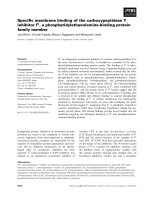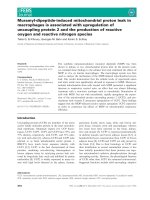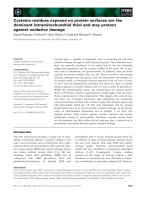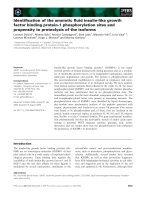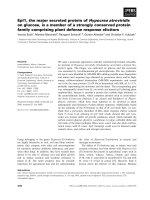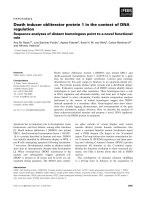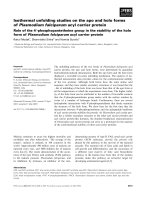Protein family review The annexins docx
Bạn đang xem bản rút gọn của tài liệu. Xem và tải ngay bản đầy đủ của tài liệu tại đây (921.74 KB, 8 trang )
Genome Biology 2004, 5:219
comment
reviews
reports deposited research
interactions
information
refereed research
Protein family review
The annexins
Stephen E Moss* and Reg O Morgan
†
Addresses: *Division of Cell Biology, Institute of Ophthalmology, 11-43 Bath Street, London EC1V 9EL, UK.
†
Department of Biochemistry and
Molecular Biology, Edificio Santiago Gascon, Faculty of Medicine, University of Oviedo, E-33006 Oviedo, Spain.
Correspondence: Stephen E Moss. E-mail:
Summary
Annexins are traditionally thought of as calcium-dependent phospholipid-binding proteins, but
recent work suggests a more complex set of functions. More than a thousand proteins of the
annexin superfamily have been identified in major eukaryotic phyla, but annexins are absent from
yeasts and prokaryotes. The unique annexin core domain is made up of four similar repeats
approximately 70 amino acids long, each of which usually contains a characteristic ‘type 2’ motif
for binding calcium ions. Animal and fungal annexins also have non-homologous amino-terminal
domains of varying length and sequence, which are responsible for the distinct localizations and
specialized functions of the proteins through post-translational modification and binding to
other proteins. Annexins interact with various cell-membrane components that are involved in
the structural organization of the cell, intracellular signaling by enzyme modulation and ion
fluxes, growth control, and they can act as atypical calcium channels. Analysis of site-specific
conservation in the core domain suggests a role for certain buried residues in the calcium-
channel activity of vertebrate annexins and in the structural stability of their core domains.
Evolutionarily significant differences between subfamilies are preferentially localized to
accessible sites on the protein surface that determine membrane binding and interactions with
cytosolic proteins.
Published: 31 March 2004
Genome Biology 2004, 5:219
The electronic version of this article is the complete one and can be
found online at />© 2004 BioMed Central Ltd
Gene organization and evolutionary history
Annexins were discovered approximately 25 years ago. The
first to be described as an isolated, purified protein was
human annexin A7 (then known as synexin) [1], and the first
to be cloned were human annexins A1 and A2 (formerly
known as lipocortin and calpactin respectively) [2,3]. The
name ‘annexin’ was proposed for the superfamily in 1990,
and the 12 annexins common to vertebrates were recently
classified in the annexin A family and named as annexins
A1-A13 (or ANXA1-ANXA13), leaving A12 unassigned in the
official nomenclature [4]. Annexins outside vertebrates are
classified into families B (in invertebrates), C (in fungi and
some groups of unicellular eukaryotes), D (in plants), and E
(in protists); at least 40 additional subfamilies await formal
classification into these families.
Most eukaryotic species have 1-20 annexin (ANX) genes
(Table 1, Figure 1); even the primitive unicellular protist
Giardia has at least seven (which are in the annexin E family)
[5,6]. The annexin genes have duplicated extensively and
independently in several eukaryotic lineages, as seen from
their molecular phylogeny, their gene structures and their
chromosomal positions. Plant annexins (the D family) make
up a monophyletic cluster whose members generally lack
amino-terminal domains and functional calcium-binding
sites in their second and third repeats [7] (see below). They
originated approximately 1,000 million years ago from the
one to three founding members in mosses, ferns and gymno-
sperms. Up to 17 additional gene subfamilies have emerged in
flowering angiosperms as a result of gene or genome dupli-
cation events, accruing additional annexins in individual
lineages (for example, one more in lilies and ten more in the
barrel medic). The eight and nine annexin genes in the com-
plete genomes of Arabidopsis and rice, respectively, include
only two true orthologs; the rest are products of lineage-
specific duplications after the separation of dicotyledonous and
monocotyledonous plants about 200-250 million years ago.
The annexin C family consists of diverse members in unicellular
organisms, represented by fungi, mycetozoa (slime molds) and
the newly defined kingdom of chromalveolates (a grouping of
chromist stramenopiles, including brown algae and diatoms,
and alveolates, including ciliates and dinoflagellates). Individ-
ual species in these groups may have no annexins (yeasts), one
to three (other fungi), or up to six (potato rot). Members of the
annexin B family, found in both protostome and deuterostome
invertebrates, have also undergone many lineage-specific
duplications, leading to more than 20 subfamilies whose gene
organization, protein structures and chromosomal maps differ
between clades and from vertebrate annexins. Insect annexins
exemplify the complex pattern of duplication and loss in indi-
vidual lineages: tsetse flies and mosquitoes have four annex-
ins, whereas Drosophila, honeybees and silkmoths have only
three, of which only one or two are clear orthologs between
species. The early-branching deuterostomes - sea urchins,
tunicates and lancelets - have 5-12 annexins; these include
close relatives of annexins A13, A7 and A11, the founder genes
of vertebrate annexins [8,9]. Although this establishes the
invertebrate ancestry of vertebrate annexins, none of the 12
annexins in the vertebrate A family have (yet) been assigned a
true invertebrate ortholog.
The vertebrate A family includes the 12 annexins that have
been confirmed to make up the complete family in
mammals, but the number of annexins may vary in other
classes of vertebrates as genes have been gained and lost.
Ancient polyploidization events in bony fish, and more
recent genome duplications in pseudotetraploid frogs
(Xenopus), have duplicated many of the annexin genes.
Thus, annexin A1 has undergone two successive duplications
to yield up to four copies in some fish, amphibians and birds.
Mammalian ANXA6 is a compound gene, probably derived
from the fusion of duplicated ANXA5 and ANXA10 genes in
early vertebrate evolution (the two halves of the encoded
protein are indicated as 5ЈANX6 and 3ЈANX6 in Figure 1).
Annexins A7, A8 and A10 have not yet been detected in fish,
although genes similar to annexin A7 have been found in
earlier-diverging species such as the sea urchin, the earth-
worm and Hydra. The reasons for the tendency of annexin
genes (or their chromosomal regions) to duplicate, their suc-
cessful preservation, and the extent to which they contribute
to vertebrate complexity are as yet unknown.
The 12 human annexin genes range in size from 15 kb
(ANXA9) to 96 kb (ANXA10) and are dispersed throughout
the genome on chromosomes 1, 2, 4, 5, 8, 9, 10 and 15 [10].
Annexin genes from other vertebrates may vary slightly in
size and chromosomal linkage, but orthologs are grossly
similar in their sequence and splicing patterns (Figure 2a).
Characteristic structural features
All annexins share a core domain made up of four similar
repeats, each approximately 70 amino acids long. Each
219.2 Genome Biology 2004, Volume 5, Issue 4, Article 219 Moss and Morgan />Genome Biology 2004, 5:219
Table 1
Annexin genes in different groups of organisms
Group Number of genes
Vertebrates
Primates 12
Mammals 12
Birds 10
Amphibians
Western clawed frog 13
African clawed frog 19
Teleost fish
Pufferfish 15
Zebrafish 21
Cartilaginous fish >1
Invertebrates
Deuterostomes
Urchins 10
Tunicates 5
Lancelets 3
Protostomes
Molluscs 6
Crustacea 2
Insects 4
Roundworms 4-5
Flatworms 9
Cnidaria (Hydra)4
Mycetozoa
Dictyostelium 2
Fungi
Ascomycetes-Perizomycotina 3
Yeasts 0
Basidiomycetes (mushrooms, rusts) 3
Stramenopiles
Diatoms 3
Moulds 6
Alveolates
Ciliates 3
Plants
Angiosperms
Dicots
Rosids 8-13
Asterids 7
Caryophyllales 5
Monocots 10
Amborella, lilies 4
Gymnosperms (cycads, gingkoes, conifers) 3
Ferns 2
Mosses 3
Protists
Diplomonads (Giardia)~7
Numbers given have been confirmed by sequence data; they are final only
for completed genomes of certain mammals (human and mouse), insects
(Drosophila) and roundworms (C. elegans).
repeat is made up of five ␣ helices and usually contains a
characteristic ‘type 2’ motif for binding calcium ions with the
sequence ‘GxGT-[38 residues]-D/E’ (in the single-letter
amino-acid code; see Figure 2b). Animal and fungal annex-
ins also have variable amino-terminal domains.
Amino-acid site conservation in a sequence alignment of
vertebrate annexins can be analyzed statistically using
hidden Markov models [11,12] to generate a signature logo
[13,14] (Figure 2c). The levels of conservation and the fre-
quency of amino acids at each site reflect both evolutionary
selection on the site and its functional importance. The simi-
larity in sequence between individual repeats (especially
repeats 2 and 4) is evident. The calcium-binding motif is
most conserved in repeat 2; in annexin A10, the motif in
repeat 2 is the only such motif. The exon splice patterns and
alternating intron phases in annexin genes do not corre-
spond to domains within the proteins, a feature that has
effectively precluded exon shuffling. The high level of con-
servation of features such as the four carboxy-terminal
repeats contrasts with unique amino termini in different
annexins, and there are also smaller differences between
them in specific parts of the proteins (Figure 3). Annexins
bind to a wide variety of other proteins (Table 2). Many
annexins have posttranslational modifications, such as phos-
phorylation and myristoylation (Figure 3); such modifica-
tions and surface remodeling of individual members
presumably account for much of the subfamily specificity in
annexin interactions. An intriguing, recurring connection
between annexins and structural proteins, such as actin, is
suggested by genetic anomalies such as the fusion in
Drosophila of an annexin gene with a dynein intermediate-
chain gene [15] and in Ciona intestinalis of a gene similar
(on the basis of its exon-splicing pattern) to ANXA11 with an
intermediate-filament gene [16,17].
The core domains of most vertebrate annexins have been
analyzed by X-ray crystallography, revealing conservation
of their secondary and tertiary structures [18-20] despite
only 45-55% amino-acid identity among individual
members. Each annexin repeat is folded into five ␣ helices
(Figure 2b,c), and these in turn are wound into a right-
handed super-helix. The four repeats pack into a structure
that resembles a flattened disc, with a slightly convex
surface on which the Ca
2+
-binding loops are located and a
concave surface at which the amino and carboxyl termini
come into close apposition (Figure 4). An innovative and
powerful approach to associating protein structural
domains with intrinsic function or functional divergence
involves the incorporation of evolutionary information into
three-dimensional models [21-23]. The family sequence
logo defines universally conserved sites (Figure 2), which
can be mapped as a color or shading scheme onto the
surface-exposed atoms of a crystallographic model [24] to
reveal localized domains of probable relevance to the basic
function of the protein (Figure 4a). A more complicated
problem in the study of large protein families is the deter-
mination of which structural differences are responsible for
functional specificity in each subfamily. Because functional
constraint guides evolutionary selection, the sites that
change in an evolutionarily significant way can be inferred
to be responsible for functional divergence. Thus, shifts in
site-specific evolutionary rates during speciation (computed
from site variations in multiple sequence alignments
derived from a broad range of species) or a conserved
change in an amino-acid property at a critical location may
consolidate a functional change at that site. We present
such a comparative analysis of annexins A1, A2 and A5
(Figure 4b) to identify the sites at which each differs
significantly from other annexins and which, in terms of
comment
reviews
reports deposited research
interactions
information
refereed research
Genome Biology 2004, Volume 5, Issue 4, Article 219 Moss and Morgan 219.3
Genome Biology 2004, 5:219
Figure 1
The phylogenetic distribution of annexins. A tree showing the
classification of annexins into five families, ANXA to ANXE, which
correspond with different eukaryotic lineages that originated at different
periods over the past 1,200 million years (Mya, million years ago). Names
of the vertebrate annexins are shown, but those of other members of the
superfamily are omitted for simplicity.
ANXA2
ANXA9
ANXA1
ANXA3
ANXA10
ANXA5
ANXA8
3′ANXA6
ANXA4
ANXA11
5′ANXA6
ANXA7
ANXA13
Protists
ANXE1-E7
Plants
ANXD1-D20
ANXC1-C9
(Mycetozoa,
Fungi,
Stramenopiles,
Alveolates)
Vertebrates
ANXA1-A13
Invertebrates
ANXB1-B14
Double genome duplication (450-500 Mya)
1,000
Mya
Circa 1,200 Mya
219.4 Genome Biology 2004, Volume 5, Issue 4, Article 219 Moss and Morgan />Genome Biology 2004, 5:219
Figure 2
Gene structures, protein domains and signature logos of vertebrate annexins. (a) The organization of the regions of family-A annexin genes encoding the core
carboxy-terminal region. Exon numbers are shown above each gene; introns are indicated by vertical lines and homologous intron positions by dotted lines.
The structures of the nine human annexin genes not shown are the same as that of ANXA11. ANXA13 is thought to have the gene structure closest to the
ancestral vertebrate annexin gene; ANXA7 is intermediate between ANXA13 and the others, and most closely resembles ANXA11 in its amino-terminal half and
ANXA13 in its carboxy-terminal half. (b) Annexin proteins generally consist of a unique amino-terminal region (of 0-191 amino acids in vertebrates, for
example) and a carboxy-terminal ‘core region’ of four homologous repeats, each 68-69 amino acids long and containing five ␣ helices and a type-2 calcium
binding site with the sequence GxGT-[38 residues]-D/E. The indicated residues Glu89 and Arg265 are considered key components of the putative calcium
channel function. (c) Sequence logo for the core domain of vertebrate annexins, derived from a hidden Markov model [11] generated from an alignment of
311 amino acids from 200 sequences representing the 12 subfamilies in 50 vertebrate species. The full height of each residue stack reflects the conservation
level at that position; the height of symbols within the stack indicates the relative frequency of each amino acid [12]. The two parts of the calcium-binding motif
(GxGT and D/E) are indicated by asterisks. The four repeats are aligned to the right on their calcium-binding motifs.
ααααα ααααα ααααα ααααα
(b)
(c)
ANXA13
ANXA7
ANXA11
(a)
α α
α
α α
* **
**
* **
* ** *
*
*
*
evolutionary dynamics, may indicate a key structure-function
adaptation. For example, annexin A2 orthologs incorporate
additional basic residues into a group of amino acids (posi-
tions 48-56) that is accessible on the concave (cytosolic) face
of the molecule (Figure 4b). The functional significance of
this divergence is consistent with a possible nuclear-local-
ization signal in annexin A2, although any such hypothesis
requires empirical testing. An extreme case of adaptive evo-
lution is that of annexin A9, an ancient duplicated relative
of annexin A2, in which all four calcium-binding sites on
the convex surface have been eradicated by evolutionary
selection. Comparable divergence patterns in annexins A1
and A5, which are in distinct evolutionary clades of the A-
family annexins, reveal patterns of structural divergence
between subfamilies that localize principally to sites
exposed on the protein surface that are most likely to be
involved in intermolecular interactions, such as the KGD
motif that is an inherited characteristic of the clade contain-
ing annexins A1, A2, and A9. These contrast with the uni-
versally conserved sites common to all annexins, which are
confined to the central, interior portion of the molecule
(Figure 4a). This approach, involving differentiation
between universally conserved sites (important for the
general function of a family) and discrete rate changes
(which affect binding to other proteins and which may be
responsible for the properties of individual annexins) may
eventually help to resolve the molecular basis for the multi-
faceted functional profiles of individual annexin proteins.
Localization and function
Annexins are generally cytosolic proteins, with pools of both a
soluble form and a form stably or reversibly associated with
components of the cytoskeleton or proteins that mediate inter-
actions between the cell and the extracellular matrix (matricel-
lular proteins). Some, such as annexins A11 and A2, have been
found in the nucleus under particular circumstances [25,26]. In
certain instances, annexins may be expressed at the cell
surface, despite the absence of any secretory signal peptide; for
example, annexin A1 translocates from the cytosol to the cell
surface following exposure of cells to glucocorticoids [27], and
annexin A2 is constitutively expressed at the surface of vascular
endothelial cells where it functions in the regulation of blood
clotting [28]. The expression level and tissue distribution of
annexins span a broad range, from abundant and ubiquitous
(annexins A1, A2, A4, A5, A6, A7, A11) to selective (such as
annexin A3 in neutrophils and annexin A8 in the placenta and
skin) or restrictive (such as annexin A9 in the tongue, annexin
A10 in the stomach and annexin A13 in the small intestine).
The presence of multiple annexins in all higher eukaryotic cell
types suggests fundamental roles in cell biology [5], even
though prokaryotes and yeasts appear to tolerate their
absence, but the apparent functional diversity within the
family remains perplexing. The development of knockout mice
has provided insight into the functions of annexins A1, A2, A5,
A6 and A7. Loss of ANXA1 leads to changes in the inflam-
matory response and the effects of glucocorticoids [29],
whereas the ANXA2 knockout mouse has defects in neovascu-
larization and fibrin homeostasis [30]. The ANXA5 and
ANXA6 knockout mice have subtler phenotypes and need
further investigation [31,32], and two independently derived
ANXA7 null mutant mouse strains are either embryonic lethal
[33] or show changes in calcium homeostasis [34]. The
diversity of phenotype in the annexin knockout mice is
consistent with these proteins having largely independent
functions. Roles for annexins that have been established from
studies using cultured cells are not always reflected in pheno-
typic abnormalities in the corresponding knockout mice,
suggesting that functional redundancy may, in some instances,
obscure the full range of functions of these multifunctional
proteins. In mice that lack an overt phenotype, there is now the
opportunity to test molecular theories of annexin function,
such as the proposed calcium channel activity of annexin A5.
Frontiers
The definition of the biological processes in which annexins
are involved has progressed through the use of gene knock-
outs and imaging. On the basis of studies using live cell
imaging and targeted gene disruption, roles have now been
unequivocally established for annexin A1 in inflammation,
annexin A2 in vesicle traffic and annexin A7 in regulation of
comment
reviews
reports deposited research
interactions
information
refereed research
Genome Biology 2004, Volume 5, Issue 4, Article 219 Moss and Morgan 219.5
Genome Biology 2004, 5:219
Table 2
Proteins that interact with vertebrate annexins
Annexin Interacting proteins
ANXA1 Epithelial growth factor receptor, formyl peptide receptor,
selectin, actin, integrin A4
ANXA2 Tissue plasminogen activator, angiostatin, insulin receptors,
tenascin C, caveolin 1
ANXA3 None known
ANXA4 Lectins, glycoprotein 2
ANXA5 Collagen type 2, vascular endothelial growth factor
receptor2, integrin B5, protein kinase C, cellular
modulator of immune recognition (MIR), G-actin, helicase,
DNA (cytosine-5-)methyltransferase 1 (DNMT1)
ANXA6 Calcium-responsive heat stable protein-28 (CRHSP-28), ras
GTPase activating protein, chondroitin, actin
ANXA7 Sorcin, galectin
ANXA8 None known
ANXA9 None known
ANXA10 None known
ANXA11 Programmed cell death 6 (PDCD6), sorcin
ANXA13 Neural precursor cell expressed, developmentally down-
regulated 4 (NEDD4)
cell growth. The ubiquity and stability of annexins suggest
some fundamental role of the unique core domain in cellular
physiology, possibly involving adhesion mechanics, membrane
traffic, signal transduction and/or developmental processes.
To the extent that annexins may have adapted to the particular
needs of their host species, molecular-evolution studies offer
some insight into which structural changes may be responsi-
ble for their functional diversity, but biological data remain
scant for nonvertebrate annexins. Transcript expression
studies using microarrays and RNA interference offer new
219.6 Genome Biology 2004, Volume 5, Issue 4, Article 219 Moss and Morgan />Genome Biology 2004, 5:219
Figure 3
Domain structures of representative annexin proteins. Orthologs of the 12 human annexins shown in other vertebrates have the same structures, with
strict conservation of the four repeats in the core region (black) and variation in length and sequence in the amino-terminal regions (shaded). Human
ANXA1 and ANXA2 are shown as dimers, with the member of the S100 protein family that they interact with. Domain structures for other model
organisms are derived from public data made available by the relevant genome-sequencing projects. Features: S100Ax, sites for attachment of the
indicated member of the S100 family of calcium-binding proteins; P, known phosphorylation sites; K, KGD synapomorphy (a conserved, inherited
characteristic of proteins); I, codon insertions (+x denotes the number of codons inserted); S-A/b, nonsynonymous coding polymorphisms (SNPs) with
the amino acid in the major variant (A) and that in the minor variant (b); N, putative nucleotide-binding sites; D, codon deletions (-x denotes the number
of codons deleted); A, alternatively spliced exons; Myr, myristoylation. The total length of each protein is indicated on the right.
0 100 200 300 400 500 600 700 800
Myr
S100A6
S100A11
S100A10
P
Ciona intestinalis
and C. savignyi
Homo sapiens
Caenorhabditis elegans
Schistosoma mansoni
Giardia lamblia
Dictyostelium discoideum
466/488
505
316/357
321
320
327
345
324
Viridiplantae
339
667/673
346
320
535
327
329
320
324
320
322
321/486
322
497
317
351
331-365
462
487
314-330
312-327
295-337
Drosophila melanogaster
Bombyx mori
KK
I+1P
K
K
K
S-I/n S-P/L S-F/s
P S-S/n
K
S-G/t
K
N
N
D-1 A
S-R/q
A
S-A/s
S-M/L
D-1
I+1 S-A/g
S-T/a S-D/g I D-1 S-R/q K
S-R/c
S-I/v
S-V/i
Protein length (amino acids)
778
K
K
K
K
AK S-R/h S-V/i
K
K
K
D-1
K
A
A
P
ANXA1
ANXA2
ANXA3
ANXA4
ANXA5
ANXA6
ANXA7
ANXA8
ANXA9
ANXA10
ANXA11
ANXA13
ANXA1
ANXA2
ci0100137443
ci0100146873
ci0100136930
ci0100153678
ci0100138049
ANXB9
ANXB10
ANXB11
ANXB13
nex-1
nex-3
nex-2
nex-4
ANXC1
ANXC2
ANXD1-D3
ANXD4-D20
About 7 proteins
About 9 proteins
experimental approaches that could implicate annexins in
some defined cellular process or pathway.
Long-standing problems also remain to be addressed. Do
individual annexins have different functions in different cell
types? How are annexins secreted? Can annexins be classi-
fied into groups with integrated functions, or are they func-
tionally independent of each other? These and many other
questions, and perhaps most importantly the need to under-
stand mechanism, will occupy annexin biologists for years to
come. The discovery of annexins with negligible calcium-
binding capacity and growing evidence for interactions with
other proteins may make the traditional definition of annexins
as calcium-dependent phospholipid-binding proteins super-
fluous in the near future.
Acknowledgements
This work was supported by grant number BMC2002-00827 from the Min-
istry of Science and Technology, Spain, and by the Wellcome Trust, UK.
References
1. Creutz CE, Pazoles CJ, Pollard HB: Identification and purifica-
tion of an adrenal medullary protein (synexin) that causes
calcium-dependent aggregation of isolated chromaffin gran-
ules. J Biol Chem 1978, 253:2858-2866.
The first isolation of a protein of the annexin family (now called
annexin A7) and demonstration of its role in vesicle fusion.
2. Huang KS, Wallner BP, Mattaliano RJ, Tizard R, Burne C, Frey A,
Hession C, McGray P, Sinclair LK, Chow EP, et al.: Two human 35
kD inhibitors of phospholipase A2 are related to substrates
of pp60v-src and of the epidermal growth factor
receptor/kinase. Cell 1986, 46:191-199.
Two proteins, now known as annexins A1 and A2, that were originally
characterized as inhibitors of phospholipase A
2
.
comment
reviews
reports deposited research
interactions
information
refereed research
Genome Biology 2004, Volume 5, Issue 4, Article 219 Moss and Morgan 219.7
Genome Biology 2004, 5:219
Figure 4
Surface mapping of important sites onto the three-dimensional structure of annexins. All panels show the crystal structure of the core region of the pig
annexin A1 protein (Protein Data Bank code:1MCX [19]), viewed frontally (left) and laterally inverted (right) as a space-filling model rendered by the
RasTop 2.0 version of RasMol [24]. Residues are numbered as in Figure 2, and the approximate positions of the conserved repeats are indicated with
Roman numerals. (a) Functionally important sites common to all annexins. The level of evolutionary conservation in clusters of residues is indicated by
lighter or darker shading. This is derived from a maximum-likelihood analysis of a multiple sequence alignment from 200 vertebrate A-family annexins
using CONSURF [22,23]. NT, amino terminus. (b) Sites that are functionally divergent between annexin subfamilies are shown with different shading for
ANXA1, ANXA2 or ANXA5, three annexins for which the differences are especially significant. The sites were assessed by ‘rate-shift analysis’ of
subfamily sequence alignments using DIVERGE [21] RATE4SITE and CONSURF [22,23]. Calcium atoms are indicated by Ca.
48-56
113,157
25
27
181
194
224
256
259-260
299
66-67
25
27
299
256
48-56
231
181
152
III
II
IV
I
III
II
IV
I
I
I
IV
IV
II
II
III
III
39
8
(NT)
Ca
Ca
Ca
Ca
Ca
Ca
Ca
Ca
Ca
111
195
270
272
274
1234567
8
9
Variable Average Conserved
Subfamily divergence
ANXA2ANXA1 ANXA5
Ca
Ca
Ca
Ca
Ca
Ca
Ca
Ca
Ca
155
300
140,139
99,98
162
213
212
220
217
209
133 128
(a)
(b)
3. Saris CJ, Tack BF, Kristensen T, Glenney JR Jr, Hunter T: The
cDNA sequence for the protein-tyrosine kinase substrate
p36 (calpactin I heavy chain) reveals a multidomain protein
with internal repeats. Cell 1986, 46:201-212.
One of the first annexins to be cloned; it derived its name from its
ability to bind calcium and bundle F-actin.
4. Human Gene Nomenclature Committee
[http//www.gene.ucl.ac.uk/nomenclature/]
The official nomenclature source of the Human Gene Organization
(HUGO) for human genes and their cognate orthologs.
5. Gerke V, Moss SE: Annexins: from structure to function. Physiol
Rev 2002, 82:331-371.
A comprehensive review on annexins.
6. Giardia lamblia genome project
[ />The site of the Giardia lamblia ATCC 50803 genome project.
7. Clark GB, Thompson G Jr, Roux SJ: Signal transduction mecha-
nisms in plants: an overview. Curr Sci 2001, 80:170-177.
A review of plant annexin functional genomics.
8. Iglesias JM, Morgan RO, Jenkins NA, Copeland NG, Gilbert DJ, Fer-
nandez MP: Comparative genetics and evolution of annexin
A13 as the founder gene of vertebrate annexins. Mol Biol Evol
2002,19:608-618.
Annexins A13, A7 and A11, the founder genes of vertebrate annexins,
are the only ones likely to have either cognate orthologs or direct
common ancestors in invertebrates.
9. Morgan RO, Bell DW, Testa JR, Fernandez MP: Genomic loca-
tions of ANX11 and ANX13 and the evolutionary genetics
of human annexins. Genomics 1998, 48:100-110.
Cladistic and computational analysis of nucleotide substitutions in
coding regions yielded estimates for the order, molecular dating and
functional constraints on annexin gene divergence.
10. Fernandez MP, Morgan RO: Structure, function and evolution
of the annexin gene superfamily. In The Annexins - Biological
Importance and Annexin-related Pathologies. Edited by Bandorowicz-
Pikula J. Georgetown, TX: Landes Bioscience; 2003:21-37.
A summary of annexin gene structures, chromosomal maps and
protein evolution.
11. Eddy SR: Profile hidden Markov models. Bioinformatics 1998,
14:755-763.
This reference and the website in [12] pioneered the development and
application of HMMs in sequence comparisons.
12. HMMER: profile HMMs for protein sequence analysis
[ />See [11].
13. Schuster-Böckler B, Schultz J, Rahmann S: HMM logos for visual-
ization of protein families. BMC Bioinformatics 2004, 5:7.
This reference and the website in [14] give a visual representation of
multiple sequence alignments based on profile hidden Markov models.
14. Logos for Sequences, Profiles, and HMMs
[ />See [13].
15. Ranz JM, Ponce AR, Hartl DL, Nurminsky D: Origin and evolution
of a new gene expressed in Drosophila sperm axoneme.
Genetica 2003, 118:233-244.
Describes the creation of a unique gene fusion that transformed an
annexin into the promoter of a dynein intermediate chain gene.
16. Dehal P, Satou Y, Campbell RK, Chapman J, Degnan B, De Tomaso
A, Davidson B, Di Gregorio A, Gelpke M, Goodstein DM, et al.: The
draft genome of Ciona intestinalis: insights into chordate and
vertebrate origins. Science 2002, 298:2157-2167.
Genome assembly data identify five urochordate annexins, including
one fused to an intermediate filament gene encoding a novel transcript.
17. Ciona intestinalis v1.0 genome resources at the Joint
Genome Institute [
See [16].
18. Liemann S, Huber R: Three-dimensional structure of annexins.
Cell Mol Life Sci 1997, 53:516-521.
A review on the structural biology of annexins.
19. Rosengarth A, Luecke H: A calcium-driven conformational
switch of the N-terminal and core domains of annexin A1. J
Mol Biol 2003, 326:1317-1325.
Calcium binding in the core tetrad was observed to release the amino-
terminal domain enabling external binding interactions.
20. Annexin Structure and Function [ />An excellent web resource for those who seek further information on
annexins, including links to many annexin labs.
21. Gu X: Statistical methods for testing functional divergence
after gene duplication. Mol Biol Evol 1999, 16:1664-1674.
Site-specific changes in evolutionary rate during speciation offer one
approach to localize functionally divergent domains within gene families,
although the validity of this approach may depend on adequate repre-
sentation by an extensive range of species groups.
22. Glaser F, Pupko T, Paz I, Bell RE, Bechor D, Martz E, Ben-Tal N:
ConSurf: Identification of functional regions in proteins by
surface-mapping of phylogenetic information. Bioinformatics
2003, 19:163-164.
The web-server described here and found at [23] incorporates evolu-
tionary information based on multiple alignments and phylogenetic
trees into three-dimensional protein models.
23. The ConSurf server []
See [22].
24. RasTop [ />Graphical interface to RasMol for modeling the 43 annexin protein
structures now in the Protein Data Bank.
25. Tomas A, Moss SE: Calcium- and cell cycle-dependent associa-
tion of annexin 11 with the nuclear envelope. J Biol Chem 2003,
278:20210-20216.
A demonstration using live cell imaging that annexin A11 associates in a
reversible calcium-dependent manner with the nuclear envelope.
26. Eberhard DA, Karns LR, VandenBerg SR, Creutz CE: Control of
the nuclear-cytoplasmic partitioning of annexin II by a
nuclear export signal and by p11 binding. J Cell Sci 2001,
114:3155-3166.
This paper provides evidence that nuclear translocation of annexin A2
is regulated in part by sequestration in the cytosol by the S100A10
calcium-binding protein, also called p11.
27. Solito E, Nuti S, Parente L: Dexamethasone-induced transloca-
tion of lipocortin (annexin) 1 to the cell membrane of U-937
cells. Br J Pharmacol 1994, 112:347-348.
Demonstration that a glucocorticoid analog stimulates the translocation
of annexin A1 to the cell surface, providing an important advance in
understanding the anti-inflammatory function of annexin A1.
28. Brownstein C, Falcone DJ, Jacovina A, Hajjar KA: A mediator of
cell surface-specific plasmin generation. Ann NY Acad Sci 2001,
947:143-155.
A review that discusses the cell-surface expression of annexin A2 and
its role in the regulation of plasmin generation.
29. Hannon R, Croxtall JD, Getting SJ, Roviezzo F, Yona S, Paul-Clark
MJ, Gavins FN, Perretti M, Morris JF, Buckingham JC, Flower RJ:
Aberrant inflammation and resistance to glucocorticoids in
annexin 1-/- mouse. FASEB J 2003, 17:253-255.
The first report of a phenotype for the annexin A1 knockout mouse.
30. Ling Q, Jacovina AT, Deora A, Febbraio M, Simantov R, Silverstein
RL, Hempstead B, Mark WH, Hajjar KA: Annexin II regulates
fibrin homeostasis and neoangiogenesis in vivo. J Clin Invest
2004, 113:38-48.
Although the annexin A2 null mutant mouse develops a normal vascu-
lature, it has a severely reduced capacity to create new blood vessels.
31. Brachvogel B, Dikschas J, Moch H, Welzel H, von der Mark K,
Hofmann C, Poschl E: Annexin A5 is not essential for skeletal
development. Mol Cell Biol 2003, 23:2907-2913.
The annexin A5 knockout mouse lacks any clear phenotype, confound-
ing theories about annexin A5 function in anticoagulation, collagen
binding and bone formation.
32. Hawkins TE, Roes J, Rees D, Monkhouse J, Moss SE: Immunologi-
cal development and cardiovascular function are normal in
annexin VI null mutant mice. Mol Cell Biol 1999, 19:8028-8032.
The annexin A6 knockout mouse is essentially normal; initial characteri-
zation revealed little in the way of functional insights.
33. Srivastava M, Atwater I, Glasman M, Leighton X, Goping G, Caohuy
H, Miller G, Pichel J, Westphal H, Mears D, et al.: Defects in inosi-
tol 1,4,5-trisphosphate receptor expression, Ca(2+) signal-
ing, and insulin secretion in the anx7(+/-) knockout mouse.
Proc Natl Acad Sci USA 1999, 96:13783-13788.
The first annexin A7 knockout mouse is embryonic lethal, with a severe
phenotype even in the heterozygotes.
34. Herr C, Smyth N, Ullrich S, Yun F, Sasse P, Hescheler J, Fleischmann
B, Lasek K, Brixius K, Schwinger RH, et al.: Loss of annexin A7
leads to alterations in frequency-induced shortening of iso-
lated murine cardiomyocytes. Mol Cell Biol 2001, 21:4119-4128.
The second annexin A7 knockout mouse is essentially normal, with a
modest cardiomyocyte phenotype.
219.8 Genome Biology 2004, Volume 5, Issue 4, Article 219 Moss and Morgan />Genome Biology 2004, 5:219

